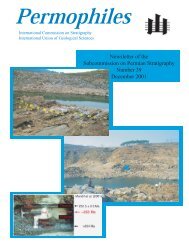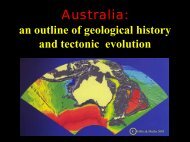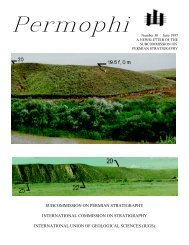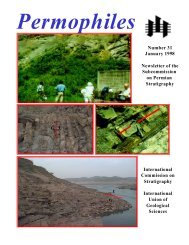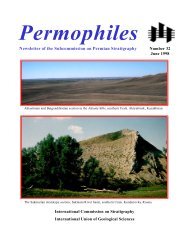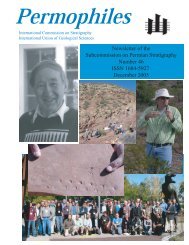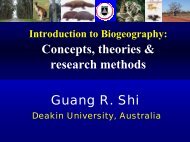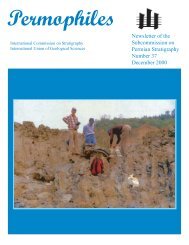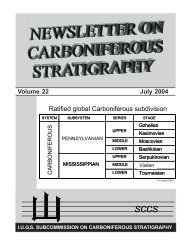fossils are frequently present in <str<strong>on</strong>g>the</str<strong>on</strong>g>se beds. Accordingly, <str<strong>on</strong>g>the</str<strong>on</strong>g> sequenceboundary or <str<strong>on</strong>g>the</str<strong>on</strong>g> maximum regressi<strong>on</strong> lies <strong>on</strong> <str<strong>on</strong>g>the</str<strong>on</strong>g> top <str<strong>on</strong>g>of</str<strong>on</strong>g> Bed5 at Tieqiao, and <str<strong>on</strong>g>the</str<strong>on</strong>g> top <str<strong>on</strong>g>of</str<strong>on</strong>g> Bed 3 at Penglaitan.The top <str<strong>on</strong>g>of</str<strong>on</strong>g> <str<strong>on</strong>g>the</str<strong>on</strong>g> uppermost shallowing-upward cycle <str<strong>on</strong>g>of</str<strong>on</strong>g><str<strong>on</strong>g>the</str<strong>on</strong>g> “lowstand” unit is <str<strong>on</strong>g>the</str<strong>on</strong>g> transgressive surface (VanWagnor et al., 1988, 1990). The early transgressive systemstract (Bed 5f to Bed 6h in Tieqiao, Bed 3c6 to Bed 6k inPenglaitan) with thick-bedded crinoid grainst<strong>on</strong>e andlenticular packst<strong>on</strong>e, reflects an overall deepening. Theserocks c<strong>on</strong>sist <str<strong>on</strong>g>of</str<strong>on</strong>g> high frequency cycles <str<strong>on</strong>g>of</str<strong>on</strong>g> fining upwarddepositi<strong>on</strong>. Each cycle is dominated by <str<strong>on</strong>g>the</str<strong>on</strong>g> hummocky,cross-stratified crinoid grainst<strong>on</strong>e in <str<strong>on</strong>g>the</str<strong>on</strong>g> lower porti<strong>on</strong>,lenticular packst<strong>on</strong>e in <str<strong>on</strong>g>the</str<strong>on</strong>g> upper, and <str<strong>on</strong>g>of</str<strong>on</strong>g>ten with verticalburrows or infilling structures at <str<strong>on</strong>g>the</str<strong>on</strong>g> top. The facies changeis interpreted to range from proximal slope depositi<strong>on</strong> withplatform-derived sediments to fine-grained deposits <str<strong>on</strong>g>of</str<strong>on</strong>g>relative deeper below-wave-base facies to <str<strong>on</strong>g>the</str<strong>on</strong>g> intertidalenvir<strong>on</strong>ment. The c<strong>on</strong>od<strong>on</strong>ts <str<strong>on</strong>g>of</str<strong>on</strong>g> <str<strong>on</strong>g>the</str<strong>on</strong>g> Jinog<strong>on</strong>dolella grantiand Clarkina postbitteri z<strong>on</strong>es are associated with depositi<strong>on</strong><str<strong>on</strong>g>of</str<strong>on</strong>g> <str<strong>on</strong>g>the</str<strong>on</strong>g> earliest TST, and occur mostly in <str<strong>on</strong>g>the</str<strong>on</strong>g> lenticularpackst<strong>on</strong>e. It is obvious that <str<strong>on</strong>g>the</str<strong>on</strong>g>re were depositi<strong>on</strong>alhiatuses between all cycles, however, n<strong>on</strong>e <str<strong>on</strong>g>of</str<strong>on</strong>g> <str<strong>on</strong>g>the</str<strong>on</strong>g>m aresignificant in term <str<strong>on</strong>g>of</str<strong>on</strong>g> <str<strong>on</strong>g>the</str<strong>on</strong>g> resoluti<strong>on</strong> <str<strong>on</strong>g>of</str<strong>on</strong>g> c<strong>on</strong>od<strong>on</strong>tchr<strong>on</strong>ostratigraphy because most <str<strong>on</strong>g>of</str<strong>on</strong>g> <str<strong>on</strong>g>the</str<strong>on</strong>g>m occur within <str<strong>on</strong>g>the</str<strong>on</strong>g>same c<strong>on</strong>od<strong>on</strong>t z<strong>on</strong>e.The last two cycles in <str<strong>on</strong>g>the</str<strong>on</strong>g> Penglaitan Secti<strong>on</strong> arerespectively composed <str<strong>on</strong>g>of</str<strong>on</strong>g> Bed 6h - 6i lower and Bed 6i upper-6k. The lower beds c<strong>on</strong>tain abundant mud-rich intraclasts(Bed 6i upper), numerous small solitary corals (Bed 6j), oro<str<strong>on</strong>g>the</str<strong>on</strong>g>r platform-derived sediments. Wavy bedding between<str<strong>on</strong>g>the</str<strong>on</strong>g> neighbouring couplets is distinct, but well developedburrows are <strong>on</strong>ly seen from <str<strong>on</strong>g>the</str<strong>on</strong>g> upper part <str<strong>on</strong>g>of</str<strong>on</strong>g> Bed 6k. Thecycle <str<strong>on</strong>g>of</str<strong>on</strong>g> Bed 6h - 6i lower indicates a much faster andwidespread transgressi<strong>on</strong> starting in <str<strong>on</strong>g>the</str<strong>on</strong>g> top part <str<strong>on</strong>g>of</str<strong>on</strong>g> <str<strong>on</strong>g>the</str<strong>on</strong>g>Laibin Limest<strong>on</strong>e. The flooding event is delineated by <str<strong>on</strong>g>the</str<strong>on</strong>g>occurrence <str<strong>on</strong>g>of</str<strong>on</strong>g> <str<strong>on</strong>g>the</str<strong>on</strong>g> C. postbitteri c<strong>on</strong>od<strong>on</strong>t Z<strong>on</strong>e extendingnorthward to <str<strong>on</strong>g>the</str<strong>on</strong>g> Chengzhou Basin <str<strong>on</strong>g>of</str<strong>on</strong>g> sou<str<strong>on</strong>g>the</str<strong>on</strong>g>rn Hunan, farbey<strong>on</strong>d <str<strong>on</strong>g>the</str<strong>on</strong>g> distributi<strong>on</strong> <str<strong>on</strong>g>of</str<strong>on</strong>g> <str<strong>on</strong>g>the</str<strong>on</strong>g> underlying c<strong>on</strong>od<strong>on</strong>ts <str<strong>on</strong>g>of</str<strong>on</strong>g> <str<strong>on</strong>g>the</str<strong>on</strong>g>J. granti Z<strong>on</strong>e.The subsequent transgressive unit (Bed 7) in Penglaitan iscomposed <str<strong>on</strong>g>of</str<strong>on</strong>g> deepening-upward cycles from lenticular mud limest<strong>on</strong>edeposited below storm-wave-base to chert <str<strong>on</strong>g>of</str<strong>on</strong>g> <str<strong>on</strong>g>the</str<strong>on</strong>g> shelf-basinfacies, with or without clay bed at <str<strong>on</strong>g>the</str<strong>on</strong>g> base. This transgressiveunit is a resp<strong>on</strong>se to <str<strong>on</strong>g>the</str<strong>on</strong>g> most rapid sea-level rise at <str<strong>on</strong>g>the</str<strong>on</strong>g> time <str<strong>on</strong>g>of</str<strong>on</strong>g> <str<strong>on</strong>g>the</str<strong>on</strong>g>C. dukouensis Z<strong>on</strong>e.Fossil successi<strong>on</strong>sC<strong>on</strong>od<strong>on</strong>ts from <str<strong>on</strong>g>the</str<strong>on</strong>g> Laibin Limest<strong>on</strong>e in both Tieqiao andPenglaitan secti<strong>on</strong>s are exclusively dominated byJinog<strong>on</strong>dolella species in <str<strong>on</strong>g>the</str<strong>on</strong>g> basal part (Bed 2 at Tieqiao andBed 2 at Penglaitan) and Clarkina species in <str<strong>on</strong>g>the</str<strong>on</strong>g> upper part (<str<strong>on</strong>g>the</str<strong>on</strong>g>upper part <str<strong>on</strong>g>of</str<strong>on</strong>g> Bed 5 to Bed 8 at Tieqiao; <str<strong>on</strong>g>the</str<strong>on</strong>g> uppermost Bed 3 toBed 6). The lower part <str<strong>on</strong>g>of</str<strong>on</strong>g> <str<strong>on</strong>g>the</str<strong>on</strong>g> Laibin Limest<strong>on</strong>e (Bed 3 to <str<strong>on</strong>g>the</str<strong>on</strong>g>middle <str<strong>on</strong>g>of</str<strong>on</strong>g> Bed 5 at Tieqiao; Bed 3 (except <str<strong>on</strong>g>the</str<strong>on</strong>g> uppermost part) atPenglaitan) is dominated by Hindeodus. Rare specimens <str<strong>on</strong>g>of</str<strong>on</strong>g>shallow water elements like Sweetognathus fenshanensis andIranognathus erwini were also recovered respectively within <str<strong>on</strong>g>the</str<strong>on</strong>g>lower Bed 3 and 6k at Penglaitan. Jinog<strong>on</strong>dolella and ClarkinaPermophiles Issue #38 200132species also dominate c<strong>on</strong>od<strong>on</strong>ts from equivalent beds at <str<strong>on</strong>g>the</str<strong>on</strong>g>Fengshan Secti<strong>on</strong>, but c<strong>on</strong>tain more comm<strong>on</strong> to abundantnearshore shallow water elements Hindeodus, Sweetognathusfenshanensis, Iranognathus erwini, and Sweetina (in order <str<strong>on</strong>g>of</str<strong>on</strong>g>decreasing abundance). Based <strong>on</strong> <str<strong>on</strong>g>the</str<strong>on</strong>g> stratigraphic range andevoluti<strong>on</strong> <str<strong>on</strong>g>of</str<strong>on</strong>g> species <str<strong>on</strong>g>of</str<strong>on</strong>g> Jinog<strong>on</strong>dolella and Clarkina, threeephylogenetic c<strong>on</strong>od<strong>on</strong>t z<strong>on</strong>es are recognized around <str<strong>on</strong>g>the</str<strong>on</strong>g>Guadalupian and Wuchiapingian boundary in Tieqiao andPenglaitan secti<strong>on</strong>s: <str<strong>on</strong>g>the</str<strong>on</strong>g> Jinog<strong>on</strong>dolella granti Z<strong>on</strong>e rangesfrom upper part <str<strong>on</strong>g>of</str<strong>on</strong>g> Bed 5 through Bed 6h in <str<strong>on</strong>g>the</str<strong>on</strong>g> Tieqiao Secti<strong>on</strong>,and from <str<strong>on</strong>g>the</str<strong>on</strong>g> uppermost Bed 3 through 6i (4.8m thick) in <str<strong>on</strong>g>the</str<strong>on</strong>g>Penglaitan Secti<strong>on</strong>; <str<strong>on</strong>g>the</str<strong>on</strong>g> Clarkina postbitteri Z<strong>on</strong>e ranges fromBed 6i through lower Bed 9 in <str<strong>on</strong>g>the</str<strong>on</strong>g> Tieqiao Secti<strong>on</strong>, and from 6jthrough 7d in <str<strong>on</strong>g>the</str<strong>on</strong>g> Penglaitan Secti<strong>on</strong>; <str<strong>on</strong>g>the</str<strong>on</strong>g> Clarkina postbitteriZ<strong>on</strong>e is overlain by <str<strong>on</strong>g>the</str<strong>on</strong>g> Clarkina dukouensis Z<strong>on</strong>e that starts atBed 7e in <str<strong>on</strong>g>the</str<strong>on</strong>g> Penglaitan Secti<strong>on</strong>. Recently, <str<strong>on</strong>g>the</str<strong>on</strong>g> Clarkinapostbitteri Z<strong>on</strong>e in <str<strong>on</strong>g>the</str<strong>on</strong>g> Penglaitan secti<strong>on</strong> has been subdividedinto two subz<strong>on</strong>es: <str<strong>on</strong>g>the</str<strong>on</strong>g> lower Clarkina postbitterih<strong>on</strong>gshuiensis subsp. nov. Subz<strong>on</strong>e ranges through 6j, and <str<strong>on</strong>g>the</str<strong>on</strong>g>upper Clarkina postbitteri postbitteri Subz<strong>on</strong>e ranges from 6kthrough 7d. Clarkina postbitteri h<strong>on</strong>gshuiensis subsp. nov. istransiti<strong>on</strong>al between Jinog<strong>on</strong>dolella granti or Jinog<strong>on</strong>dolellacr<str<strong>on</strong>g>of</str<strong>on</strong>g>ti and Clarkina postbitteri postbitteri. It is close toJinog<strong>on</strong>dolella granti in its denticulati<strong>on</strong> with closely spaceddenticles and less reduced anterior platform and it is close toClarkina postbitteri postbitteri with a high anterior blade, ausually much more reduced anterior platform and lack <str<strong>on</strong>g>of</str<strong>on</strong>g> anteriorplatform serrati<strong>on</strong>.Fusulinaceans are rich in <str<strong>on</strong>g>the</str<strong>on</strong>g> Maokouan-Lopingian boundarysuccessi<strong>on</strong> <str<strong>on</strong>g>of</str<strong>on</strong>g> <str<strong>on</strong>g>the</str<strong>on</strong>g> Laibin secti<strong>on</strong>. The lower part <str<strong>on</strong>g>of</str<strong>on</strong>g> <str<strong>on</strong>g>the</str<strong>on</strong>g> LaibinLimest<strong>on</strong>e comprises <str<strong>on</strong>g>the</str<strong>on</strong>g> fusulinaceans <str<strong>on</strong>g>of</str<strong>on</strong>g> <str<strong>on</strong>g>the</str<strong>on</strong>g> Metadoliolina Z<strong>on</strong>e.The upper part <str<strong>on</strong>g>of</str<strong>on</strong>g> this Member is referred to an acme z<strong>on</strong>e, <str<strong>on</strong>g>the</str<strong>on</strong>g>Lantschichites minima Z<strong>on</strong>e. This z<strong>on</strong>e is very thin, <strong>on</strong>ly 2 metresin thickness. The Cod<strong>on</strong><str<strong>on</strong>g>of</str<strong>on</strong>g>usiella kueichowensis Z<strong>on</strong>e is recognizedin <str<strong>on</strong>g>the</str<strong>on</strong>g> beds with <str<strong>on</strong>g>the</str<strong>on</strong>g> c<strong>on</strong>od<strong>on</strong>t Clarkina postbitteri in <str<strong>on</strong>g>the</str<strong>on</strong>g>Tieqiao Secti<strong>on</strong>, which c<strong>on</strong>tains m<strong>on</strong>ot<strong>on</strong>ous Cod<strong>on</strong><str<strong>on</strong>g>of</str<strong>on</strong>g>usiella andReichelina. The newly established Palae<str<strong>on</strong>g>of</str<strong>on</strong>g>usulina jiangxianaZ<strong>on</strong>e occurs in <str<strong>on</strong>g>the</str<strong>on</strong>g> lower part <str<strong>on</strong>g>of</str<strong>on</strong>g> <str<strong>on</strong>g>the</str<strong>on</strong>g> Heshan Formati<strong>on</strong>, whichalso c<strong>on</strong>tain <str<strong>on</strong>g>the</str<strong>on</strong>g> Clarkina asymmetrica c<strong>on</strong>od<strong>on</strong>t Z<strong>on</strong>e and rangeupward to <str<strong>on</strong>g>the</str<strong>on</strong>g> C. guangyuanensis c<strong>on</strong>od<strong>on</strong>t Z<strong>on</strong>e.Amm<strong>on</strong>oids referred to Waagenoceras have been found in<str<strong>on</strong>g>the</str<strong>on</strong>g> topmost part <str<strong>on</strong>g>of</str<strong>on</strong>g> <str<strong>on</strong>g>the</str<strong>on</strong>g> Maokou Formati<strong>on</strong> (Bed 6k) at <str<strong>on</strong>g>the</str<strong>on</strong>g>Penglaitan Secti<strong>on</strong>. This fact implies that Maokouan amm<strong>on</strong>oidsextend upward into <str<strong>on</strong>g>the</str<strong>on</strong>g> C. postbitteri Z<strong>on</strong>e as do <str<strong>on</strong>g>the</str<strong>on</strong>g> amm<strong>on</strong>oidsfrom <str<strong>on</strong>g>the</str<strong>on</strong>g> same z<strong>on</strong>e in sou<str<strong>on</strong>g>the</str<strong>on</strong>g>rn Hunan.Magnetostratigraphic investigati<strong>on</strong> and isotopic datingFor magnetostratigraphic investigati<strong>on</strong>, Menning collected640 oriented cylinders from <str<strong>on</strong>g>the</str<strong>on</strong>g> Chihsia, Maokou and basal part <str<strong>on</strong>g>of</str<strong>on</strong>g><str<strong>on</strong>g>the</str<strong>on</strong>g> Heshan formati<strong>on</strong>s at <str<strong>on</strong>g>the</str<strong>on</strong>g> Tieqiao Secti<strong>on</strong> and <str<strong>on</strong>g>the</str<strong>on</strong>g> Guadalupian-Lopingian boundary sequence at <str<strong>on</strong>g>the</str<strong>on</strong>g> Penglaitan Secti<strong>on</strong> (Menninget al., 1996). Partial or total remagnetizati<strong>on</strong> complicates <str<strong>on</strong>g>the</str<strong>on</strong>g>magnetostratigraphic research. Isotopic age <str<strong>on</strong>g>of</str<strong>on</strong>g> <str<strong>on</strong>g>the</str<strong>on</strong>g> tuff beds at <str<strong>on</strong>g>the</str<strong>on</strong>g>Penglaitan Secti<strong>on</strong> has been studied since 1995, and <str<strong>on</strong>g>the</str<strong>on</strong>g> tuff bed<str<strong>on</strong>g>of</str<strong>on</strong>g> <str<strong>on</strong>g>the</str<strong>on</strong>g> late Changhsingian was dated as 252.4 ± 0.2 Ma by Bowringet al. (1998). Samples from Bed 6a and 7c near <str<strong>on</strong>g>the</str<strong>on</strong>g> boundary in <str<strong>on</strong>g>the</str<strong>on</strong>g>Penglaitan Secti<strong>on</strong> are under analysis.
ChemostratigraphyValues for δ 13 C drop from + 2.0 per mil in <str<strong>on</strong>g>the</str<strong>on</strong>g> Laibin Limest<strong>on</strong>eto -0.7 per mil at <str<strong>on</strong>g>the</str<strong>on</strong>g> base <str<strong>on</strong>g>of</str<strong>on</strong>g> <str<strong>on</strong>g>the</str<strong>on</strong>g> Heshan Formati<strong>on</strong> (Bed 8a to Bed8c, <str<strong>on</strong>g>the</str<strong>on</strong>g> upper par <str<strong>on</strong>g>of</str<strong>on</strong>g> <str<strong>on</strong>g>the</str<strong>on</strong>g> C. postbitteri Z<strong>on</strong>e), return to an averagevalue in Bed 9, and jump to <str<strong>on</strong>g>the</str<strong>on</strong>g> highest value 5%δ 13 C in <str<strong>on</strong>g>the</str<strong>on</strong>g> reefcarb<strong>on</strong>ate <str<strong>on</strong>g>of</str<strong>on</strong>g> <str<strong>on</strong>g>the</str<strong>on</strong>g> Heshan Formati<strong>on</strong>. Change <str<strong>on</strong>g>of</str<strong>on</strong>g> isotope str<strong>on</strong>tiumvalue is c<strong>on</strong>sistent with isotope carb<strong>on</strong> with a dramatic drop in Bed8a to Bed 8c. (Wang et al., in press ).In summary, <str<strong>on</strong>g>the</str<strong>on</strong>g> Penglaitan and <str<strong>on</strong>g>the</str<strong>on</strong>g> Tieqiao secti<strong>on</strong>s are excellentsecti<strong>on</strong>s in which to establish a finely resolved chr<strong>on</strong>ologyand meet with <str<strong>on</strong>g>the</str<strong>on</strong>g> requirements for serving as GSSP. However, <str<strong>on</strong>g>the</str<strong>on</strong>g>Penglaitan Secti<strong>on</strong> is preferred as <str<strong>on</strong>g>the</str<strong>on</strong>g> GSSP for <str<strong>on</strong>g>the</str<strong>on</strong>g> Guadalupian-Lopingian boundary because <str<strong>on</strong>g>of</str<strong>on</strong>g> excellent outcrops <str<strong>on</strong>g>of</str<strong>on</strong>g> bothWuchiapingian and Changhsingian beds.Potential stratotype pointsTwo levels are presented here for selecti<strong>on</strong>. The proposal for<str<strong>on</strong>g>the</str<strong>on</strong>g> FAD <str<strong>on</strong>g>of</str<strong>on</strong>g> Clarkina dukouensis at bed 6k is not regarded as anacceptable choice for selecti<strong>on</strong> because <str<strong>on</strong>g>the</str<strong>on</strong>g> basal boundary <str<strong>on</strong>g>of</str<strong>on</strong>g> <str<strong>on</strong>g>the</str<strong>on</strong>g>C. dukouensis Z<strong>on</strong>e, after fur<str<strong>on</strong>g>the</str<strong>on</strong>g>r study by c<strong>on</strong>od<strong>on</strong>t experts, is atbed 114-7d <str<strong>on</strong>g>of</str<strong>on</strong>g> <str<strong>on</strong>g>the</str<strong>on</strong>g> Penglaitan Secti<strong>on</strong>, which is just above a claybed (114-7c) that may indicate c<strong>on</strong>siderable envir<strong>on</strong>mental change(Jin, 2000). A detailed study proved that specimens <str<strong>on</strong>g>of</str<strong>on</strong>g> Clarkinafrom bed 6k bel<strong>on</strong>g to Clarkina postbitteri ra<str<strong>on</strong>g>the</str<strong>on</strong>g>r than to earlyforms <str<strong>on</strong>g>of</str<strong>on</strong>g> Clarkina dukouensis (Henders<strong>on</strong> et al., 2000; Henders<strong>on</strong>,2001) and herein, bed 6k (Figure 1) is reported to c<strong>on</strong>tain <str<strong>on</strong>g>the</str<strong>on</strong>g> firstappearance <str<strong>on</strong>g>of</str<strong>on</strong>g> Clarkina postbitteri postbitteri (Henders<strong>on</strong> et al.,this issue).Opti<strong>on</strong> A:This opti<strong>on</strong> is a point defined by <str<strong>on</strong>g>the</str<strong>on</strong>g> FAD <str<strong>on</strong>g>of</str<strong>on</strong>g> Clarkinapostbitteri h<strong>on</strong>gshuiensis subsp. nov. (Henders<strong>on</strong> and Mei, inpress) that occurs within an evoluti<strong>on</strong>ary lineage fromJinog<strong>on</strong>dolella granti to Clarkina postbitteri postbitteri.Henders<strong>on</strong> et al. provide <str<strong>on</strong>g>the</str<strong>on</strong>g> informal descripti<strong>on</strong>s <str<strong>on</strong>g>of</str<strong>on</strong>g> <str<strong>on</strong>g>the</str<strong>on</strong>g>se taxaelsewhere in this issue <str<strong>on</strong>g>of</str<strong>on</strong>g> Permophiles.The FAD <str<strong>on</strong>g>of</str<strong>on</strong>g> C. postbitteri h<strong>on</strong>gshuiensis is close to <str<strong>on</strong>g>the</str<strong>on</strong>g> boundarysurface between <str<strong>on</strong>g>the</str<strong>on</strong>g> Middle and <str<strong>on</strong>g>the</str<strong>on</strong>g> Upper AbsarokaMegasequences. This horiz<strong>on</strong> can be traced in different lith<str<strong>on</strong>g>of</str<strong>on</strong>g>aciesby <str<strong>on</strong>g>the</str<strong>on</strong>g> recogniti<strong>on</strong> <str<strong>on</strong>g>of</str<strong>on</strong>g> ei<str<strong>on</strong>g>the</str<strong>on</strong>g>r <str<strong>on</strong>g>the</str<strong>on</strong>g> major sequence boundary or aremarkable changeover from c<strong>on</strong>od<strong>on</strong>t faunas dominated byJinog<strong>on</strong>dolella below in <str<strong>on</strong>g>the</str<strong>on</strong>g> Maokouan to those dominated byClarkina above with total absence <str<strong>on</strong>g>of</str<strong>on</strong>g> Jinog<strong>on</strong>dolella in <str<strong>on</strong>g>the</str<strong>on</strong>g>Wuchiapingian. The c<strong>on</strong>od<strong>on</strong>t successi<strong>on</strong> around <str<strong>on</strong>g>the</str<strong>on</strong>g> Guadalupian– Lopingian boundary is marked by a rapid change fromJinog<strong>on</strong>dolella into Clarkina. C<strong>on</strong>sequently, it would be easy tolocate <str<strong>on</strong>g>the</str<strong>on</strong>g> Guadalupian-Lopingian boundary close to <str<strong>on</strong>g>the</str<strong>on</strong>g> sequenceboundary by <str<strong>on</strong>g>the</str<strong>on</strong>g> level <str<strong>on</strong>g>of</str<strong>on</strong>g> lowest occurrence <str<strong>on</strong>g>of</str<strong>on</strong>g> Clarkina and o<str<strong>on</strong>g>the</str<strong>on</strong>g>rcorresp<strong>on</strong>ding stratigraphic markers.Permophiles Issue #38 2001Two questi<strong>on</strong>s are raised by this opti<strong>on</strong>. The first is that <str<strong>on</strong>g>the</str<strong>on</strong>g>occurrence <str<strong>on</strong>g>of</str<strong>on</strong>g> Clarkina postbitteri in Texas is in dispute. Henders<strong>on</strong>and Mei are c<strong>on</strong>vinced that <str<strong>on</strong>g>the</str<strong>on</strong>g> illustrated highest c<strong>on</strong>od<strong>on</strong>ts inWest Texas are Jinog<strong>on</strong>dolella xuanhanensis cr<str<strong>on</strong>g>of</str<strong>on</strong>g>ti, which appearedprior <str<strong>on</strong>g>the</str<strong>on</strong>g> global maximum regressi<strong>on</strong>. Wardlaw suggeststhat Clarkina postbitteri is present in West Texas. A model <str<strong>on</strong>g>of</str<strong>on</strong>g>c<strong>on</strong>vergent evoluti<strong>on</strong> may accommodate a new subspecies <str<strong>on</strong>g>of</str<strong>on</strong>g>Clarkina postbitteri evolving from Jinog<strong>on</strong>dolella cr<str<strong>on</strong>g>of</str<strong>on</strong>g>ti in Texas,which subsequently became extinct as <str<strong>on</strong>g>the</str<strong>on</strong>g> S.W. USA Delaware33Basin was drained. A sec<strong>on</strong>d lineage developed within a c<strong>on</strong>tinousmarine envir<strong>on</strong>ment from Jinog<strong>on</strong>dolella granti or from ano<str<strong>on</strong>g>the</str<strong>on</strong>g>rsubspecies derived from a Panthalassan refuge to Clarkinapostbitteri h<strong>on</strong>gshuiensis.The sec<strong>on</strong>d questi<strong>on</strong> is that a depositi<strong>on</strong>al hiatus was suggestedbelow Bed 6i upper. As described in <str<strong>on</strong>g>the</str<strong>on</strong>g> paragraph <strong>on</strong>depositi<strong>on</strong>al successi<strong>on</strong>, <str<strong>on</strong>g>the</str<strong>on</strong>g> upper part <str<strong>on</strong>g>of</str<strong>on</strong>g> <str<strong>on</strong>g>the</str<strong>on</strong>g> Laibin Limest<strong>on</strong>ec<strong>on</strong>sists <str<strong>on</strong>g>of</str<strong>on</strong>g> high frequency cycles. Both Bed 6i lower and Bed 6kform <str<strong>on</strong>g>the</str<strong>on</strong>g> upper parts <str<strong>on</strong>g>of</str<strong>on</strong>g> <str<strong>on</strong>g>the</str<strong>on</strong>g> uppermost two cycles and are fairlyc<strong>on</strong>tinuous with <str<strong>on</strong>g>the</str<strong>on</strong>g> lower parts. Though depositi<strong>on</strong>al gaps mightoccur between cycles, <str<strong>on</strong>g>the</str<strong>on</strong>g>y seem no more than those at normalbedding planes; that is, <str<strong>on</strong>g>the</str<strong>on</strong>g>y are insignificant in terms <str<strong>on</strong>g>of</str<strong>on</strong>g> <str<strong>on</strong>g>the</str<strong>on</strong>g> resoluti<strong>on</strong><str<strong>on</strong>g>of</str<strong>on</strong>g> c<strong>on</strong>od<strong>on</strong>t chr<strong>on</strong>ostratigraphy. A c<strong>on</strong>od<strong>on</strong>t z<strong>on</strong>e usuallycomprises many cycles.Some colleagues c<strong>on</strong>sider that <strong>on</strong>ly such rapid change <str<strong>on</strong>g>of</str<strong>on</strong>g>fossils and rocks permits worldwide correlati<strong>on</strong> and recogniti<strong>on</strong><str<strong>on</strong>g>of</str<strong>on</strong>g> beds <str<strong>on</strong>g>of</str<strong>on</strong>g> a defined age. Regarding <str<strong>on</strong>g>the</str<strong>on</strong>g> rapid faunal and sedimentologicalchanges as reflecting an incomplete geological record,would lead to a boundary definiti<strong>on</strong> based <strong>on</strong> subtle stratigraphicchanges that are not useful for subsequent correlati<strong>on</strong>.Opti<strong>on</strong> B.A point defined by <str<strong>on</strong>g>the</str<strong>on</strong>g> FAD at <str<strong>on</strong>g>the</str<strong>on</strong>g> base <str<strong>on</strong>g>of</str<strong>on</strong>g> Bed 6k <str<strong>on</strong>g>of</str<strong>on</strong>g> Clarkinapostbitteri postbitteri within an evoluti<strong>on</strong>ary lineage from C.postbitteri h<strong>on</strong>gshuiensis subsp. nov. to C. dukouensis. The FAD<str<strong>on</strong>g>of</str<strong>on</strong>g> C. postbitteri sensu lato could also be used to approximate thisboundary as it is <strong>on</strong>ly 20 cm below <str<strong>on</strong>g>the</str<strong>on</strong>g> defining point at <str<strong>on</strong>g>the</str<strong>on</strong>g> base<str<strong>on</strong>g>of</str<strong>on</strong>g> Bed 6i upper at <str<strong>on</strong>g>the</str<strong>on</strong>g> Penglaitan Secti<strong>on</strong>. The reas<strong>on</strong> for taking<str<strong>on</strong>g>the</str<strong>on</strong>g> name Clarkina postbitteri postbitteri is that <str<strong>on</strong>g>the</str<strong>on</strong>g> holotype <str<strong>on</strong>g>of</str<strong>on</strong>g>C. postbitteri postbitteri is from Bed 6k, <str<strong>on</strong>g>of</str<strong>on</strong>g> which <str<strong>on</strong>g>the</str<strong>on</strong>g> main partwas originally marked as Bed 115 and <str<strong>on</strong>g>the</str<strong>on</strong>g> topmost part, as Bed114.6.Clarkina postbitteri postbitteri is a transiti<strong>on</strong>al form betweenC. postbitteri h<strong>on</strong>gshuiensis and C. dukouensis. Therefore, <str<strong>on</strong>g>the</str<strong>on</strong>g>FAD <str<strong>on</strong>g>of</str<strong>on</strong>g> C. postbitteri postbitteri is defined within a gradati<strong>on</strong>allineage in which depositi<strong>on</strong> is c<strong>on</strong>tinuous.The main questi<strong>on</strong>s regarding this opti<strong>on</strong> are as follows. First,it is hardly possible to c<strong>on</strong>sistently dem<strong>on</strong>strate <str<strong>on</strong>g>the</str<strong>on</strong>g> exact point atwhich Clarkina postbitteri h<strong>on</strong>gshuiensis becomes C. postbitteripostbitteri. An arbitrary point in a morphologic transiti<strong>on</strong> is exactlythat, arbitrary, and almost certainly inc<strong>on</strong>sistent.Sec<strong>on</strong>d, alternative GSSP positi<strong>on</strong>s at <str<strong>on</strong>g>the</str<strong>on</strong>g> base <str<strong>on</strong>g>of</str<strong>on</strong>g> <str<strong>on</strong>g>the</str<strong>on</strong>g>Jinog<strong>on</strong>dolella altudaensis and C. dukouensis z<strong>on</strong>es are at leasttwo z<strong>on</strong>es away from <str<strong>on</strong>g>the</str<strong>on</strong>g> geologically important boundary definedby sequence stratigraphy and extincti<strong>on</strong>. It has been realizedthat <str<strong>on</strong>g>the</str<strong>on</strong>g>se two levels do not corresp<strong>on</strong>d to any major event inglobal biological or envir<strong>on</strong>mental change, and thus, <str<strong>on</strong>g>the</str<strong>on</strong>g>se fossilz<strong>on</strong>es al<strong>on</strong>e are not sufficient for inter-regi<strong>on</strong>al correlati<strong>on</strong> <str<strong>on</strong>g>of</str<strong>on</strong>g> <str<strong>on</strong>g>the</str<strong>on</strong>g>Guadalupian-Lopingian boundary sequences.Lopingian Boundary Working Group PreferenceThere is general agreement that <str<strong>on</strong>g>the</str<strong>on</strong>g> boundary-stratotype <str<strong>on</strong>g>of</str<strong>on</strong>g> a stageshould be located within a sequence <str<strong>on</strong>g>of</str<strong>on</strong>g> c<strong>on</strong>tinuous marine depositi<strong>on</strong>and should be associated with distinct marker horiz<strong>on</strong>s thatcan be readily recognized and widely traced as an isochr<strong>on</strong>oushoriz<strong>on</strong> and <str<strong>on</strong>g>the</str<strong>on</strong>g>refore, it should be selected at or near <str<strong>on</strong>g>the</str<strong>on</strong>g> markerhoriz<strong>on</strong>s. Unfortunately, <str<strong>on</strong>g>the</str<strong>on</strong>g>re is rarely an ideal point that can



